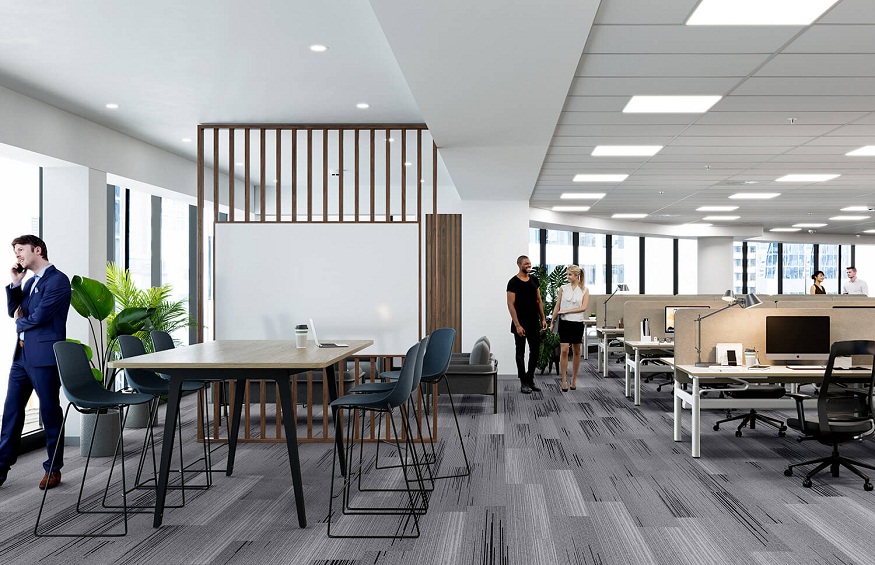In the realm of commercial premises, nothing matters more than a development or a design fit out that can make the difference between a prosperous and an underwhelming firm. I.e., if you are an experienced entrepreneur, or later in a commercial dimension you may also want to detect the details of commercial design required to create the right atmosphere that will mirror your fashion as well as productivity, efficiency, and certainly happiness, also of clients. In this comprehensive tutorial we will look at the 5 Factors To Consider In A commercial design fit out Project.
1. Cultivating a Cohesive Brand Identity
Developing a consistent brand identity is crucial because your business’s commercial space frequently serves as the initial point of contact between your clientele and your company. A customer should enter your business and immediately find themselves in an atmosphere that embodies the values, character, as well as style of your brand.
You cannot underestimate the power of first impressions. A well-designed business space can do wonders to establish an environment that looks and feels dependable, professional, and detail-oriented – at the very least setting the stage for a great client experience. You have to establish a mood and consistency in your brand identity. Every element of your commercial fit out, right from the lighting and colour scheme, to the furniture and artwork, should complement each other and have an element of commonality, creating a coherent and unforgettable experience.
Reiterating your brand’s identity through design elements is a subdued yet powerful strategy. This can be accomplished by utilising the colour scheme, logo, or even distinctive design components that capture the essence of your brand. Customers’ relationship with your brand is strengthened when you skillfully include these components across your business environment, giving them a sense of familiarity and recognition.
2. Optimising Space Utilisation and Functionality
Functionality and space optimization ought to be given top priority in the field of commercial design. In addition to improving appearance, a well-designed area also boosts efficiency, productivity, and general job happiness.
Efficient space planning maximises functionality and is a must. This involves not just the programming of circulation, spatial allocations for all the activities and to ensure the amenities and other resources are ideally located for the best means of accessible position within the subdivisions. Doing so is quick and additionally extremely useful, in simpler words, these are going to create a smooth work area for you.
3. Embracing Sustainability and Environmental Responsibility
The Sustainability To The World appeared first in the Journal. By implementing green building practices within your fit out project you will reduce your organisation’s carbon footprint, while demonstrating that you are a responsible and forward-thinking company.
Green design is crucial. Want a space that has minimal environmental impact and the potential to be less expensive for you to operate in the long run, energy efficient, water conserving, waste reducing. Moreover, a commitment to sustainability can be a major competitive advantage in a world where customers increasingly want to back businesses that share their environmental ideals, further improving your brand image and making customers want to buy with you over a competitor.
Creating sustainable commercial design, one of its pivotal attributes remains in energy-saving solutions. It may involve using LED lighting systems, high efficiency HVAC systems installation, use of natural light and ventilation strategies to cause minimal energy consumption through such buildings. You can also take this a step farther and look into using solar panels, as well as wind turbines, as renewable ways to create energy.
4. Fostering Collaboration and Creativity
We live in an age of distributed business and we all need to collaborate and come up with great ideas to innovate and outcompete. A high impact piece of commercial space can help create these vital attributes, which ultimately will help your company to grow and succeed.
Importance of Collaborative spaces, you can promote teamwork, knowledge-sharing, and idea moult by using open-plan layouts for the communal areas that will be used by these teams. Thanks to the appropriate use of wide-open workplace design.This will easily create an easy meet up area in addition to the open office desks, and utilising them as public areas,desks, along with committed meeting rooms. Such spaces would need to be versatile, easily adaptable to seating and project requirements based on varying group sizes.
Promoting interchange of ideas is very essential to create a climate of innovation and creativity. It is thus essential to incorporate breakout areas, informal seating zones or even gaming rooms or recreational spaces where employees from other departments meet and get engaged in casual conversations. Through these natural forms of interaction emerges the new fresh idea, outlook, and answer, otherwise perhaps obscured and hidden in traditional isolated work preferences.
5. Prioritising Safety and Accessibility
While aesthetics and functionality are necessary to commercial design, safety and accessibility should be top of mind for any architect. By Following the rules and regulations in real estate, combined with a consumer centric approach, you could create a space that complies with all regulations, A space which is not only inclusive to all users and visitors, but also feels safe.
Design That Is Accessible For All Inclusive Design For Retail Spaces It requires an inclusive design approach which means designing for people with additional abilities and needs by implementing wheelchair entrance points, braille signs, and audible alarms. When you prioritise accessibility, you are showing a belief in creating an environment that is approachable and open for all, no matter their physical or cognitive capabilities.
Conclusion
Success in the world of interior commercial design depends on a combination of skills that are as changing as the designs themselves. Careful reflection on the five pivotal components detailed in the guide above (cultivating a unified brand identity, making the most of your space capabilities, adopting sustainable practice, promoting collaboration and innovation, and ensuring safety and inclusivity) will ensure that your commercial space both captures customers and aids your business in its ambitions.

